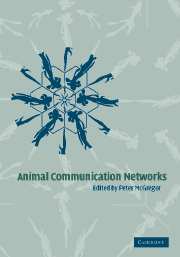Book contents
- Frontmatter
- Contents
- List of contributors
- Preface
- 1 Introduction
- Part I Behaviours specific to communication networks
- Introduction
- 2 Eavesdropping in communication networks
- 3 Public, private or anonymous? Facilitating and countering eavesdropping
- 4 Performing in front of an audience: signallers and the social environment
- 5 Fighting, mating and networking: pillars of poeciliid sociality
- 6 The occurrence and function of victory displays within communication networks
- Part II The effects of particular contexts
- Part III Communication networks in different taxa
- Part IV Interfaces with other disciplines
- Index
4 - Performing in front of an audience: signallers and the social environment
Published online by Cambridge University Press: 06 August 2010
- Frontmatter
- Contents
- List of contributors
- Preface
- 1 Introduction
- Part I Behaviours specific to communication networks
- Introduction
- 2 Eavesdropping in communication networks
- 3 Public, private or anonymous? Facilitating and countering eavesdropping
- 4 Performing in front of an audience: signallers and the social environment
- 5 Fighting, mating and networking: pillars of poeciliid sociality
- 6 The occurrence and function of victory displays within communication networks
- Part II The effects of particular contexts
- Part III Communication networks in different taxa
- Part IV Interfaces with other disciplines
- Index
Summary
Introduction
Several signallers and receivers sharing the same active signalling space constitute a communication network. This type of environment imposes additional selection pressures on both signallers and receivers other than those classically considered in signaller–receiver dyads. In this chapter, we shall discuss how communication networks influence the behaviour of a signaller and, more specifically, the effect of an audience (defined below) on signalling behaviour.
An individual signaller has to cope with two main issues when signalling in a network: (a) it has to compete or cooperate with other signallers, and (b) it has to deal with the presence of several receivers. Signalling at the same time as other individuals poses a problem for the signaller: how does it ensure that its specific signal is detected by a receiver when other conspecifics are signalling? Signallers solve or minimize this problem by either cooperating or competing for the signal broadcast space. For example, in frog and insect choruses, individuals time their signals to avoid acoustic interference (e.g. alternating their calls) or compete for call order in the chorus (Gerhardt & Huber, 2002; Ch. 13). At the community level, different species with similar signals may broadcast their signals at different times of the day (Endler, 1992).
The presence of several receivers presents two additional problems for the signaller. The first is how to direct the signal to a specific receiver. For example, bird song often has a range that encompasses several neighbouring territories.
- Type
- Chapter
- Information
- Animal Communication Networks , pp. 63 - 83Publisher: Cambridge University PressPrint publication year: 2005
- 44
- Cited by

